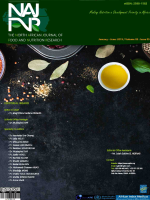Main Article Content
Comparative study of total phenolic content and antioxidant proprieties of Quercus fruit: flour and oil
Abstract
Aim: The current study was undertaken to determine the total phenolic and flavonoid contents and to assess the antioxidant activity of two different extracts (flour and oil) of two Algerian Quercus species, Quercus ilex L. and Quercus suber L.
Methods and Material: The oil extraction of the two species was achieved using the Soxhlet method. The obtained extracts were estimated for the chemical and physical constants (acidity, peroxide value, iodine value, and ultraviolet absorption indices). Total phenolic content was measured by spectrophotometry according to the Folin-Ciocalteu procedure and calculated as gallic acid equivalents (GAE). The studied extracts were submitted to an estimation of their flavonoid contents too, using aluminum chloride methods. Antioxidant ability was assessed by means of two distinct methods (DPPH• and ABTS•+).
Results: The obtained results revealed that antioxidant properties, total phenolic, and total flavonoid contents differed significantly among selected species and extracts. The flour samples possessed the highest level of total phenolic contents (1101–1464 mg GAE/kg dry weight) and exhibited the highest antioxidant capacities with average values of 52.62–40.78 μmol TE g−1 dry weight and 36.19–44.50 μmol TE g−1 dry weight for DPPH and ABTS assays, respectively. Acorn oil extracts showed also remarkable antioxidant activity, up to 2.69 and 3.23 μmol TE g−1 oil (DPPH and ABTS test, respectively), even though the total phenolic contents were low (195.64–322.06 mg GAE /kg of oil). Total phenolic amounts were positively correlated with the antioxidant properties of Quercus flour and oil.
Conclusions: Our study provides basic information on the presence of bioactive compounds and antioxidant capacity in acorn fruits, in order to consider their extracts as functional food ingredients and potential source of natural antioxidants.







